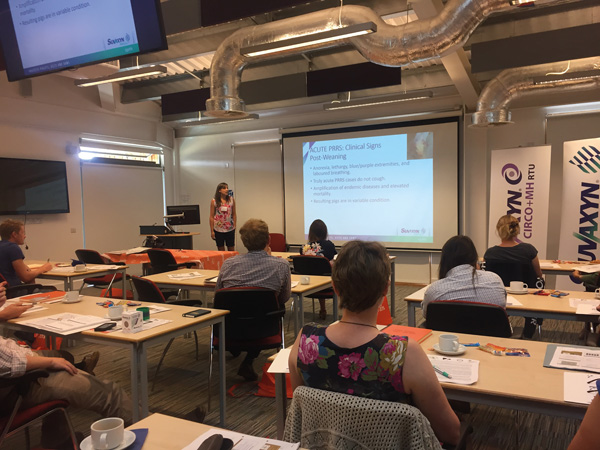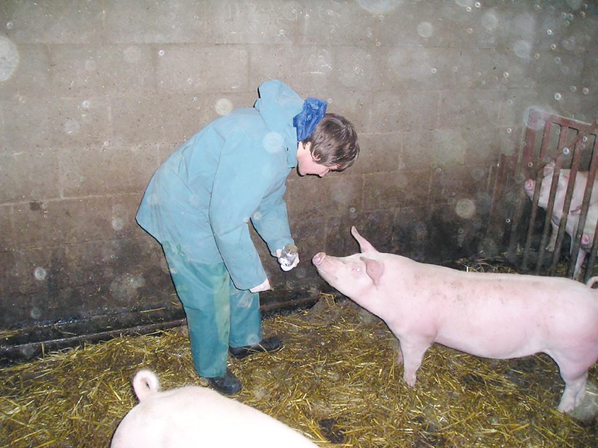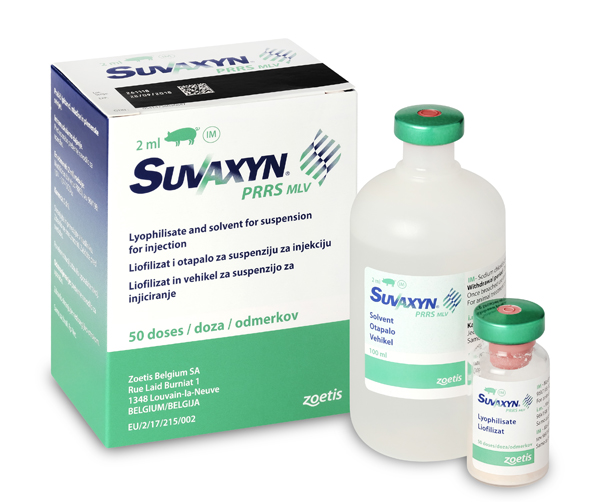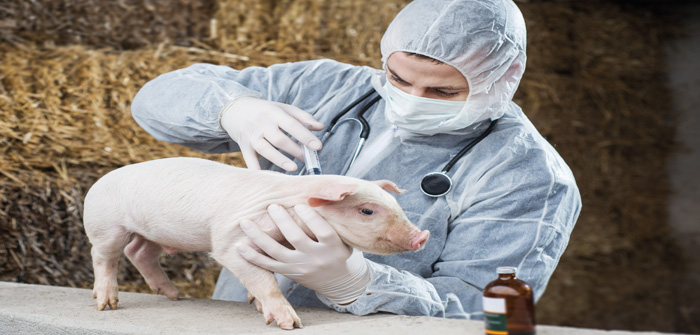Caroline Stocks reports on the four-step plan to help stay on top of this worrying viral disease.
It’s the most costly pig disease around the world, costing the European pig industry £1.5bn a year due to high piglet mortality, decreased respiratory health, reproductive issues in sows and veterinary costs.
But finding porcine reproductive and respiratory syndrome (PRRS) on your farm doesn’t have to consign your business to a future of poor productivity and increased costs.

At a recent young pig vet event, hosted by the Zoetis team in Hertfordshire, the company’s national veterinary manager, Laura Hancox (pictured above), explained how to manage the virus and protect pigs from potential infection by adhering to the four pillars of PRRS control.
Herd management
When it comes to managing PRRS in herds, virus stability pivots on gilt management, said Dr Hancox.
This involves vaccinating with a modified live PRRS vaccine by four-months-old to allow for virus shedding to subside and virus immunity to build before gilts enter a herd. Until that point they should also be isolated and given time to acclimatise.
In terms of sow management, vaccination should take place two to four times a year, depending on product recommendations, either with mass vaccination of the entire breeding stock in one go, or by using the ‘6-60’ approach, which involves vaccinating six days after farrowing and 60 days post- service.
In the farrowing house, PRRS spread can be tackled by limiting cross-fostering, euthanising severely affected pigs and adopting an all-in, all-out system.
“It’s important you don’t move poor pigs into the next batch,” Dr Hancox said. “And if you have to use foster sows, move the sow into the room, not the piglets out, as it’s unlikely that the older sows will be shedding the virus.”
In the feeding herd, mass vaccination, managing pigs all-in, all-out by airspace, good biosecurity and control of endemic diseases should also help reduce the impact of the virus.
Vaccination
When it comes to vaccination, modified live virus vaccines offer the best protection against PRRS, said Dr Hancox. Whether you vaccinate using the mass vaccination or 6-60 approach, the aims are to stop PRRS from circulating in breeding stock and wean PRRS-negative pigs.
“The key thing to remember is that the PRRS virus needs a susceptible pig to multiply and survive,” she said. “If all animals are immune at once, then the virus has nowhere to replicate, and the herd should become PRRS virus negative.”
Piglet vaccination is vital in some situations to maintain PRRS stability, she added. “On farms with farrow-to-finishing operations on a single site, it’s important to vaccinate piglets as virus circulation in the finishing herd threatens the stability of the breeding herd.
“If weaning off-site, you should vaccinate piglets if your breeding herd is unstable as some weaners will be PRRS positive – and if you are mixing health status.
“You should also vaccinate piglets if you don’t have an all-in, all-out system, or if you’ve got a high risk of PRRS introduction.”
However, if piglets come from a PRRS- stable herd – virus negative – and are weaned off-site into a high-biosecurity, all-in, all-out system, then piglet vaccination probably isn’t necessary, she added.
On farms where farmers are using one vaccine for sows and another for piglets, it’s important to only use one live vaccine in the same herd.
“Multiple vaccines will make you more likely to protect against the wild type of the virus. But there’s a risk with multiple live vaccinations of recombination creating a new strain.
“Excellent biosecurity will help reduce the risk of the virus spread and recombination, but it is important to avoid using different live vaccines.”
Biosecurity
PRRS can get onto farms in a number of ways, from bringing new animals into a system, to contaminated vehicles and equipment, people, biting flies and wildlife.
Once it’s on a farm, the highest risk of spread comes from artificial insemination and mating with a positive boar. The next highest risk is anything involving skin penetration: Just 0.01ml of blood or saliva is needed to infect an animal, so fighting, ear biting, vaccination, ear tattooing and teeth cutting can all be ways of transmitting the disease.
“The priority should be stopping PRRS from ever entering a herd, so that means management practices such as keeping a closed herd and ensuring gilts and semen come from a single, trusted source,” said Dr Hancox.
On farm, producers should introduce perimeter fencing, install a one-way loading bay at the farm’s perimeter, have a showering-in protocol, and clean and disinfect vehicles before they enter and leave a unit.
“If the virus does find its way onto a farm, then internal biosecurity to prevent it spreading across the herd is critical,” Dr Hancox added.
To reduce the spread, farmers should operate an all-in, all out policy, and introduce management and handling policies which encourage regular cleaning and disinfection of buildings and equipment.
It is also important to ensure needles are changed as often as possible – always between pens, litters, and groups – and maintain good pest control.
“Having zoned equipment can work really well, for example if you have a blue bucket and brushes for the farrowing house and yellow equipment for the weaners, you can spot straight away if something has been moved into an area it shouldn’t be in,” Dr Hancox added.
“Similarly zoned personnel can be very effective. If that’s not possible, then at least have zoned working orders so staff start with low-risk jobs and move to high-risk ones throughout the day.”
Diagnostics & monitoring
If you suspect a PRRS-negative herd has become positive, or you’re seeing an outbreak of PRRS in a previously stable herd, then diagnostics can be an important tool in understanding the strain on your farm – and how you should treat it.
Virus diagnosis can be a challenge, given that many of the signs of PRRS, such as reproductive failure, may be seen several weeks after infection, by which time the virus will have stopped shedding.
Looking for the presence of antibodies in blood can be an alternative, but these tests also raise challenges as positive results could be due to an animal being vaccinated, while negative results could be hiding an infection that the pig hasn’t yet produced antibodies against.
Testing shouldn’t stop at simply identifying an outbreak either. Monitoring PRRS in an historically positive herd is important, too.
“Monitoring is important in investigating outbreaks of clinical signs and demonstrating where PRRS is circulating in a herd,” Dr Hancox said. “But it also helps monitor changes in a strain.”
Why is mass vaccination important?
Susanna Williamson (pictured below), pig veterinary lead at the Animal and Plant Health Agency (APHA), explained how the PRRS virus is prone to change over time through both mutation and recombination, potentially leading to evolution of new PRRSV strains.

“This is not unique to the UK, but is seen globally where PRRS infects pigs,” she said. “As the virus evolves, it is possible that more virulent strains may occur or that vaccinated pigs may be less well protected against disease. Controlling PRRS infection through a combination of measures, including pig management, all-in all-out procedures, cleaning and disinfection, vaccination and other means, helps to limit the evolution of PRRS virus by minimising virus replications.”
Veterinary practitioners are also aware that controlling PRRS can help control other diseases, including those due to bacterial pathogens as the virus has an immunosuppressive effect and can thus act as a driver for antimicrobial use.
Only PRRSV-1 (European type) viruses have been detected in GB pigs to date. PRRSV-2 (North American type) has not and it is vital that measures, such as testing, are taken to prevent pigs or semen imported into the UK from introducing it, she added.
Suvaxyn PRRS MLV
To make vaccination simpler, Zoetis has developed a new live vaccine, Suvaxyn PRRS MLV, which can be given to piglets, gilts and sows.
Given to piglets from one day of age, Zoetis says it provides immunity to PRRS (28 days later) around the time of weaning – offering the earliest protection on the market – right through to slaughter.

“Being able to administer it from the first day means you can vaccinate piglets when you are handling them for other procedures, which reduces stress, and it’s one less vaccination around weaning,” said Dr Hancox.
“In the breeding herd we recommend gilts get a dose four weeks before breeding, and that sows are revaccinated every four months.
“PRRS won’t stay in the pig and the animal will eventually clear it. That’s why a whole- herd approach is key to managing the disease and getting it out of a system.”
For more information visit www.suvaxynprrs.co.uk




